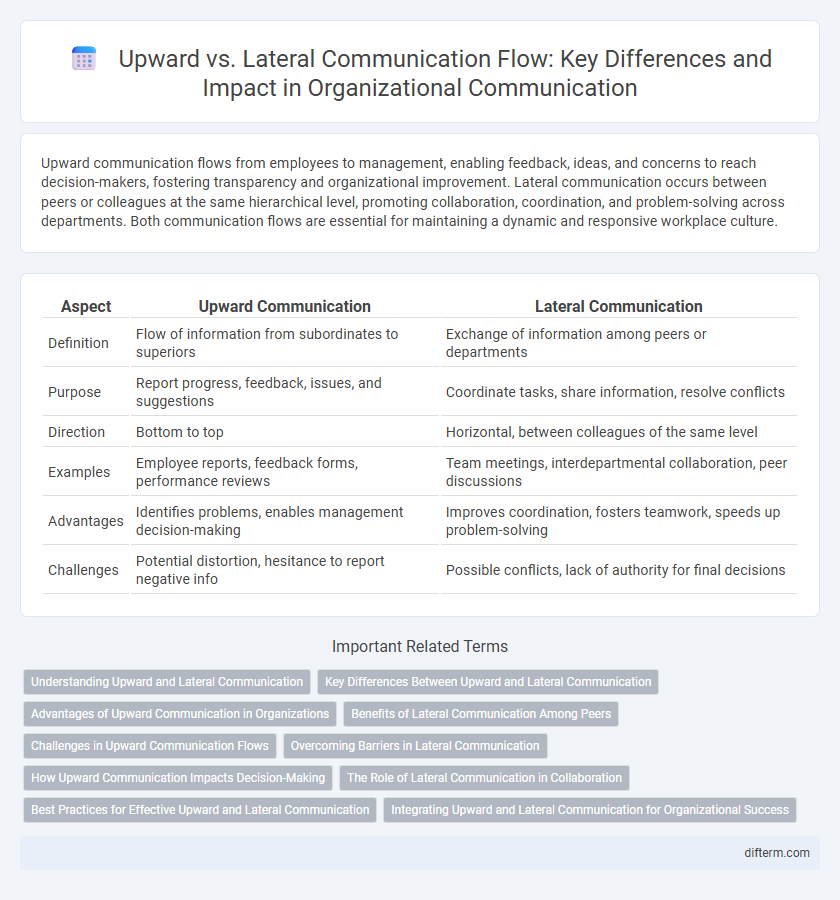Upward communication flows from employees to management, enabling feedback, ideas, and concerns to reach decision-makers, fostering transparency and organizational improvement. Lateral communication occurs between peers or colleagues at the same hierarchical level, promoting collaboration, coordination, and problem-solving across departments. Both communication flows are essential for maintaining a dynamic and responsive workplace culture.
Table of Comparison
| Aspect | Upward Communication | Lateral Communication |
|---|---|---|
| Definition | Flow of information from subordinates to superiors | Exchange of information among peers or departments |
| Purpose | Report progress, feedback, issues, and suggestions | Coordinate tasks, share information, resolve conflicts |
| Direction | Bottom to top | Horizontal, between colleagues of the same level |
| Examples | Employee reports, feedback forms, performance reviews | Team meetings, interdepartmental collaboration, peer discussions |
| Advantages | Identifies problems, enables management decision-making | Improves coordination, fosters teamwork, speeds up problem-solving |
| Challenges | Potential distortion, hesitance to report negative info | Possible conflicts, lack of authority for final decisions |
Understanding Upward and Lateral Communication
Upward communication involves the flow of information from employees to management, enabling feedback, reporting issues, and sharing innovative ideas crucial for organizational improvement. Lateral communication occurs between peers or colleagues at the same hierarchical level, facilitating coordination, problem-solving, and collaboration across departments. Understanding these communication flows enhances workplace efficiency by promoting transparency, trust, and effective teamwork.
Key Differences Between Upward and Lateral Communication
Upward communication flows from subordinates to supervisors, emphasizing feedback, reports, and requests for decision-making, while lateral communication occurs between peers or departments to coordinate activities and share information efficiently. Upward communication often involves formal channels and helps managers gauge employee morale and performance, whereas lateral communication is more informal and fosters collaboration and problem-solving. Key differences include the direction of message flow, purpose--evaluation and control for upward communication versus cooperation and coordination for lateral communication--and the typical formality of the interactions.
Advantages of Upward Communication in Organizations
Upward communication enhances employee engagement by providing a channel for feedback, suggestions, and concerns, fostering a culture of openness within organizations. It improves decision-making accuracy through the inclusion of frontline insights and real-time information from employees directly involved in daily operations. By promoting transparency and trust, upward communication helps identify potential issues early, enabling proactive problem-solving and continuous organizational improvement.
Benefits of Lateral Communication Among Peers
Lateral communication among peers enhances collaboration by enabling quick information exchange and problem-solving without hierarchical delays. It fosters a supportive work environment where team members share expertise, leading to increased innovation and productivity. This communication flow reduces misunderstandings and builds stronger interpersonal relationships crucial for organizational success.
Challenges in Upward Communication Flows
Upward communication flows often face challenges such as employee hesitation due to fear of negative consequences, selective reporting, and information distortion as messages pass through hierarchical layers. These barriers hinder accurate feedback and limit management's ability to address workplace issues effectively. Overcoming these obstacles requires establishing trust, encouraging openness, and implementing clear channels for employee input.
Overcoming Barriers in Lateral Communication
Overcoming barriers in lateral communication involves addressing challenges such as departmental silos, misaligned goals, and lack of trust among peers. Enhancing transparency, fostering collaborative cultures, and implementing regular cross-functional meetings improve information sharing and teamwork. Utilizing digital collaboration tools can also bridge gaps, ensuring timely and clear exchange of ideas across equal organizational levels.
How Upward Communication Impacts Decision-Making
Upward communication delivers crucial feedback from employees to management, fostering informed decision-making by providing ground-level insights and highlighting operational challenges. This flow enhances transparency, encourages employee engagement, and helps leaders align strategies with actual workplace conditions. Effective upward communication ensures timely identification of issues, driving agile and responsive management decisions that improve organizational performance.
The Role of Lateral Communication in Collaboration
Lateral communication enhances collaboration by enabling seamless information exchange among colleagues at the same organizational level, fostering quicker decision-making and problem-solving. It breaks down departmental silos, promotes team cohesion, and improves coordination across functions. Effective lateral communication supports innovation and agility by encouraging real-time feedback and knowledge sharing within peer groups.
Best Practices for Effective Upward and Lateral Communication
Effective upward communication involves providing clear, concise feedback and updates that facilitate decision-making and demonstrate accountability. Lateral communication thrives on timely, collaborative exchanges that promote teamwork and problem-solving across departments. Establishing regular check-ins and using transparent digital platforms enhances clarity and trust in both communication flows.
Integrating Upward and Lateral Communication for Organizational Success
Integrating upward and lateral communication enhances organizational success by fostering transparency and collaboration across hierarchical levels and departments. Upward communication channels employee feedback and insights to management, while lateral communication facilitates coordination and problem-solving among peers. Combining both flows ensures comprehensive information exchange, driving informed decision-making and a cohesive workplace culture.
upward vs lateral (communication flow) Infographic

 difterm.com
difterm.com